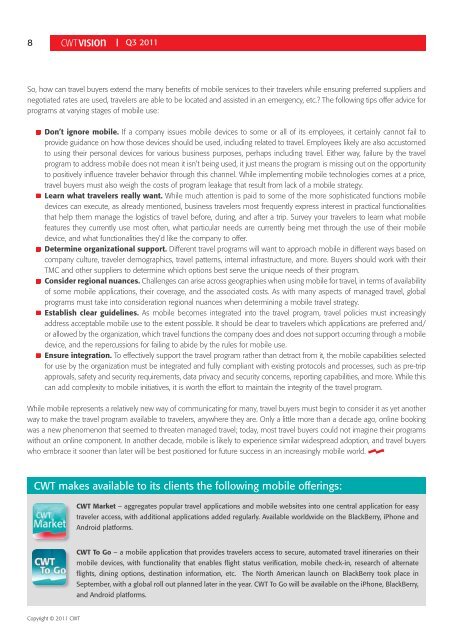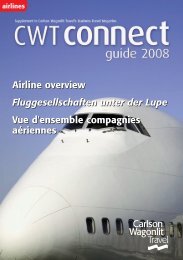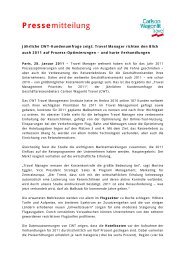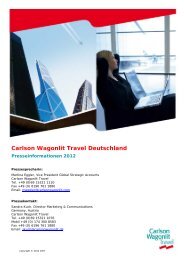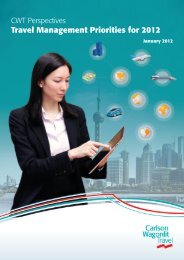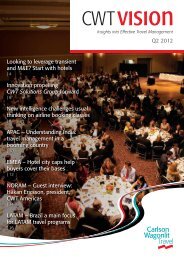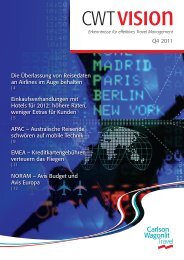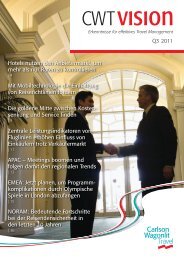CWT Vision - Carlson Wagonlit Travel
CWT Vision - Carlson Wagonlit Travel
CWT Vision - Carlson Wagonlit Travel
You also want an ePaper? Increase the reach of your titles
YUMPU automatically turns print PDFs into web optimized ePapers that Google loves.
8<br />
Copyright © 2011 <strong>CWT</strong><br />
| Q3 2011<br />
So, how can travel buyers extend the many benefi ts of mobile services to their travelers while ensuring preferred suppliers and<br />
negotiated rates are used, travelers are able to be located and assisted in an emergency, etc.? The following tips off er advice for<br />
programs at varying stages of mobile use:<br />
Don’t ignore mobile. If a company issues mobile devices to some or all of its employees, it certainly cannot fail to<br />
provide guidance on how those devices should be used, including related to travel. Employees likely are also accustomed<br />
to using their personal devices for various business purposes, perhaps including travel. Either way, failure by the travel<br />
program to address mobile does not mean it isn’t being used, it just means the program is missing out on the opportunity<br />
to positively infl uence traveler behavior through this channel. While implementing mobile technologies comes at a price,<br />
travel buyers must also weigh the costs of program leakage that result from lack of a mobile strategy.<br />
Learn what travelers really want. While much attention is paid to some of the more sophisticated functions mobile<br />
devices can execute, as already mentioned, business travelers most frequently express interest in practical functionalities<br />
that help them manage the logistics of travel before, during, and after a trip. Survey your travelers to learn what mobile<br />
features they currently use most often, what particular needs are currently being met through the use of their mobile<br />
device, and what functionalities they’d like the company to off er.<br />
Determine organizational support. Diff erent travel programs will want to approach mobile in diff erent ways based on<br />
company culture, traveler demographics, travel patterns, internal infrastructure, and more. Buyers should work with their<br />
TMC and other suppliers to determine which options best serve the unique needs of their program.<br />
Consider regional nuances. Challenges can arise across geographies when using mobile for travel, in terms of availability<br />
of some mobile applications, their coverage, and the associated costs. As with many aspects of managed travel, global<br />
programs must take into consideration regional nuances when determining a mobile travel strategy.<br />
Establish clear guidelines. As mobile becomes integrated into the travel program, travel policies must increasingly<br />
address acceptable mobile use to the extent possible. It should be clear to travelers which applications are preferred and/<br />
or allowed by the organization, which travel functions the company does and does not support occurring through a mobile<br />
device, and the repercussions for failing to abide by the rules for mobile use.<br />
Ensure integration. To eff ectively support the travel program rather than detract from it, the mobile capabilities selected<br />
for use by the organization must be integrated and fully compliant with existing protocols and processes, such as pre-trip<br />
approvals, safety and security requirements, data privacy and security concerns, reporting capabilities, and more. While this<br />
can add complexity to mobile initiatives, it is worth the eff ort to maintain the integrity of the travel program.<br />
While mobile represents a relatively new way of communicating for many, travel buyers must begin to consider it as yet another<br />
way to make the travel program available to travelers, anywhere they are. Only a little more than a decade ago, online booking<br />
was a new phenomenon that seemed to threaten managed travel; today, most travel buyers could not imagine their programs<br />
without an online component. In another decade, mobile is likely to experience similar widespread adoption, and travel buyers<br />
who embrace it sooner than later will be best positioned for future success in an increasingly mobile world.<br />
<strong>CWT</strong> makes available to its clients the following mobile off erings:<br />
<strong>CWT</strong> Market – aggregates popular travel applications and mobile websites into one central application for easy<br />
traveler access, with additional applications added regularly. Available worldwide on the BlackBerry, iPhone and<br />
Android platforms.<br />
<strong>CWT</strong> To Go – a mobile application that provides travelers access to secure, automated travel itineraries on their<br />
mobile devices, with functionality that enables fl ight status verifi cation, mobile check-in, research of alternate<br />
fl ights, dining options, destination information, etc. The North American launch on BlackBerry took place in<br />
September, with a global roll out planned later in the year. <strong>CWT</strong> To Go will be available on the iPhone, BlackBerry,<br />
and Android platforms.


